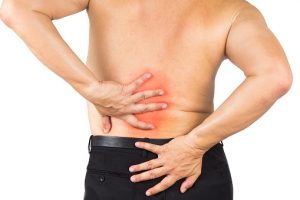 Lower back pain may be a sign of ankylosing spondylitis (AS), a type of spinal arthritis. Ankylosing spondylitis is a type of arthritis in the spine, so it is not caused by injury to the spine but rather inflammation in the vertebrae.
Lower back pain may be a sign of ankylosing spondylitis (AS), a type of spinal arthritis. Ankylosing spondylitis is a type of arthritis in the spine, so it is not caused by injury to the spine but rather inflammation in the vertebrae.
The most common symptom of ankylosing spondylitis is back pain, but the condition can spread to other joints as well. When AS becomes severe it can cause joints to fuse and reduce mobility.
Causes and symptoms of ankylosing spondylitis
Advertisement
Ankylosing spondylitis does not have a specific cause but genetic factors may play a part. Specifically, a gene called HLA-B27 has been found to increase the risk of ankylosing spondylitis.
Family history, being male and being in late adolescence are also known risk factors of ankylosing spondylitis.
Symptoms of ankylosing spondylitis are pain and stiffness in the lower back and hips, which can worsen in the morning or during times of inactivity. Common areas affected by AS are:
- The joint at the base of the spine and pelvis
- Vertebrae in the lower spine
- Places where tendon and ligaments attach to bones
- Cartilage between breastbone and ribs
- Hips and shoulders
Patients with ankylosing spondylitis found less likely to be breast fed: Study
 New research has found that patients with ankylosing spondylitis were less likely to have been breast fed as babies. The researchers examined 203 patients with the HLA-B27 gene. Researcher’s also recruited 293 siblings for a control group and a third group of 280 unrelated healthy controls.
New research has found that patients with ankylosing spondylitis were less likely to have been breast fed as babies. The researchers examined 203 patients with the HLA-B27 gene. Researcher’s also recruited 293 siblings for a control group and a third group of 280 unrelated healthy controls.
A total of 119 individuals were breast fed among all groups. Breastfeeding lasted on average up to 9.25 weeks for patients with AS and 9.43 for those without AS.
Analysis showed that only 57 percent of AS patients were breast fed compared to 72 percent among siblings. Of the 38 who were bottle fed, 40.4 percent developed AS. Of 18 families that switched between bottle and breastfeeding, no patients developed AS that were not breast fed.
Treatment of ankylosing spondylitis
Advertisement
Treatment goals of AS are to reduce pain and stiffness brought on by the condition. This can involve the use of nonsteroidal anti-inflammatory drugs (NSAIDs) or tumor necrosis (TNF) factor blockers. TNF blockers target the TNF protein, which is an inflammatory agent in arthritis.
Physical therapy is also important to help relieve pain and stiffness. Physical therapy can help boost the patient’s range of motion, flexibility, improve posture and whatever their personalized needs require.
Lastly, and only if required, surgery is an option for AS to replace damaged joints.
